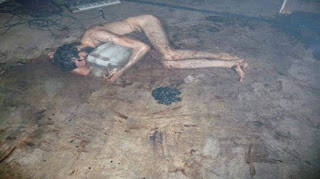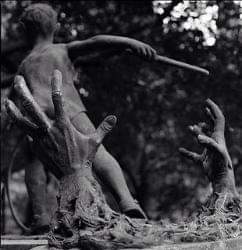The Oerlikon 20 mm cannon
The Oerlikon 20 mm cannon
The Oerlikon 20 mm cannon is a series of autocannons, based on an original German Becker Type M2 20 mm cannon design that appeared very early in World War I.
It was widely produced by Oerlikon Contraves and others, with various models employed by both Allied and Axis forces during World War II. Many versions of the cannon are still used today
OerlikonEdit
In 1927 the Oerlikon S was added to the existing product line. This fired a still larger cartridge (20x110RB) to achieve a muzzle velocity of 830 m/s (versus 490 m/s for the original Becker 20x70RB gun), at the cost of increased weight and a reduced rate of fire (280 rpm).
The purpose of this development was to improve the performance of the gun as an anti-tank and anti-aircraft weapon, which required a higher muzzle velocity. An improved version known as the 1S followed in 1930.
Three sizes of gun with their different ammunition and barrel length, but very similar mechanisms, continued to be developed in parallel.
In 1930 Oerlikon reconsidered the application of its gun in aircraft and introduced the AF and AL, designed to be used in flexible mounts, i.e. manually aimed by a gunner.
The 15-round box magazine used by earlier versions of the gun was replaced by drum magazine holding 15 or 30 rounds.
In 1935 it made an important step by introducing a series of guns designed to be mounted in or on the wings of fighter aircraft.
Designated with FF for Flügelfest meaning 'wing-mounted', these weapons were again available in the three sizes, with designations FF, FFL and FFS. The FF fired a slightly larger cartridge than the AF, 20x72RB, but the major improvement in these weapons was a significant increase in rate of fire.
The FF weighed 24 kg and achieved a muzzle velocity of 550 to 600 m/s with a rate of fire of 520 rpm. The FFL of 30 kg fired a projectile at a muzzle velocity of 675 m/s with a rate of fire of 500 rpm. And the FFS, which weighed 39 kg, delivered a high muzzle velocity of 830 m/s at a rate of 470 rpm.
Apart from changes to the design of the guns for wing-mounting and remote control, larger drums were introduced as it would not be possible to exchange magazines in flight. For the FF series 45, 60, 75 and 100 (and a rarely used 150) drum magazines were available, but most users chose the 30 or 60-round drum.
The 1930s were a period of global re-armament, and a number of foreign firms took licenses for the Oerlikon family of aircraft cannon. In France, Hispano-Suiza manufactured development of the FFS as the Hispano-Suiza HS.7 and Hispano-Suiza HS.9, for installation between the cylinder banks of its V-12 engines. In Germany, Ikaria further developed the FF gun as the MG FF, firing 20x80RB ammunition. And the Imperial Japanese Navy, after evaluating all three guns, ordered developments of the FF and FFL as the Type 99-1 and Type 99-2.
The incorporation of the improvements of the FFS in a new anti-aircraft gun produced, in 1938, the Oerlikon SS. Oerlikon realized further improvements in rate of fire on the 1SS of 1942, and the 2SS of 1945 which achieved 650 rpm. However, it was the original SS gun which was widely adopted as anti-aircraft gun, being especially widely used by Allied navies during World War II.
This gun used a 400-grain (26-gram) charge of IMR 4831 smokeless powder to propel a 2,000-grain (130-gram) projectile at 2,800 feet (850 meters) per second.[5]
World War II
The Oerlikon FF was installed as armament on some fighters of the 1930s, such as the Polish PZL P.24G. Locally produced derivatives of the Oerlikon cannon were used much more extensively, on aircraft, on ships and on land. In the air, the Ikaria MG FF was used as armament on a number of German aircraft, of which the most famous is the Messerschmitt Bf 109. The Japanese Navy similarly used their copy of the FF, designated the Type 99 Mark One cannon on a number of types including the Mitsubishi A6M Zero. Later in the war, they also equipped fighters including the Zero with the Type 99 Mark Two, a version of the more powerful and faster-firing Oerlikon FFL.
The French firm of Hispano-Suiza was a manufacturer of aircraft engines, and it marketed the moteur-canon combination of its 12X and 12Y engines with a H.S.7 or H.S.9 cannon installed between the cylinder banks. The gun fired through the hollow propeller hub, this being elevated above the crankcase by the design of the gearing. Such armament was installed on the Morane-Saulnier M.S.406 and some other types. Similar German installations of the MG FF were not successful.
The Oerlikon became best known in its naval applications. Initially the Oerlikon was not looked upon favorably by the Royal Navy as a short-range anti-aircraft gun. In 1937–1938 Lord Louis Mountbatten, then a captain in the Royal Navy, advocated within the Royal Navy to set up an unprejudiced trial for the Oerlikon 20 mm gun, but was unsuccessful. It was not until the Commander-in-Chief of the Home Fleet, Admiral Sir Roger Backhouse, was appointed First Sea Lord that Mountbatten's efforts bore fruit. During the first half of 1939 a contract for 1,500 guns was placed in Switzerland. However, due to delays and then later the fall of France in June 1940, only 109 guns reached the United Kingdom. All Oerlikon guns imported from Switzerland, in 1940, were mounted on various gun carriages to serve as light AA-guns on land.
Just a few weeks before the fall of France, the Oerlikon factory approved manufacture of their gun in the United Kingdom, under licence. The Royal Navy managed to smuggle out the necessary drawings and documents from Zürich. The production of the first British-made Oerlikon guns started in Ruislip, London, at the end of 1940. The first guns were delivered to the Royal Navy in March or April, 1941. The RAF Regiment made extensive use of Oerlikon guns in the anti-aircraft role. These were the principal armament for its light anti-aircraft squadrons in North Africa, the Middle East, Italy, and north western Europe, until the introduction of the Bofors 40/L60 40 mm gun from 1943, although many squadrons retained a mix of guns until the end of World War 2. Squadrons in the Far East were equipped exclusively with Oerlikons.
The Oerlikon gun was installed aboard United States Navy ships from 1942, replacing the M2 Browning machine gun, which lacked range and firepower, and largely superseding the 1.1"/75 caliber gun, which was heavier and had less mechanical reliability. It became famous in the naval anti-aircraft role, providing an effective defense at short ranges (in practice up to 1.5 km) at which heavier guns had difficulty tracking a target. The gun was eventually abandoned as a major anti-air weapon due to its lack of stopping power against heavy aircraft and against Japanese kamikaze attacks during the Pacific War. It was largely superseded by the Bofors 40 mm gun and the 3"/50 Mark 22 gun. It provided a useful increase in firepower over the .50 cal machine gun when adapted and fitted to some aircraft. However, it had some problems with jamming in the ammunition feed.
The Royal Canadian Navy popularised the use of the Oerlikon gun as an anti-ship and anti-submarine gun – while it was not effective against the armour of most larger ships, it was used extensively and effectively against U-boats, and on the decks of larger ships. A handful of corvettes were fitted with the weapon toward the end of the war, but it appeared more commonly on frigates and destroyers at the time.
The Oerlikon was also used as the basis for the Polsten gun, designed by Polish engineers in exile in the United Kingdom. The gun went into service in 1944, and was used well into the 1950s, among other uses, on Cromwell tanks and early model Centurion tanks.
Romania purchased 45 pieces from Germany during the first half of World War II.













Comments
Post a Comment